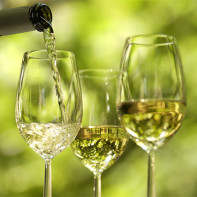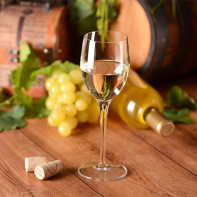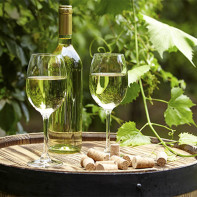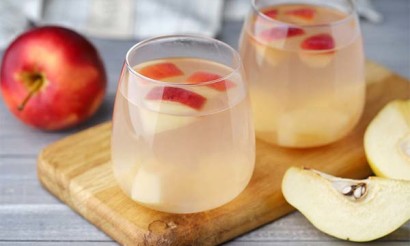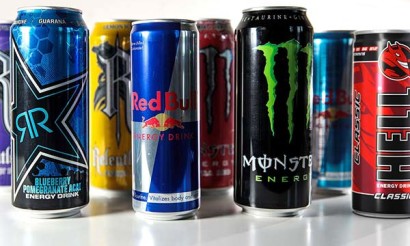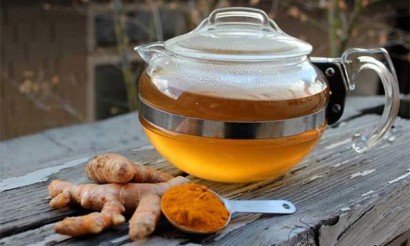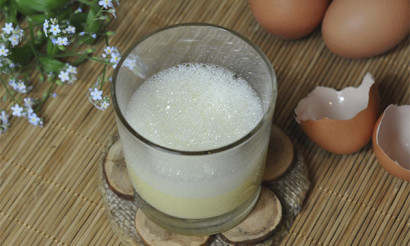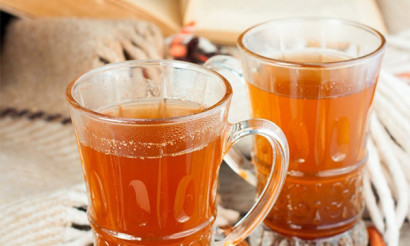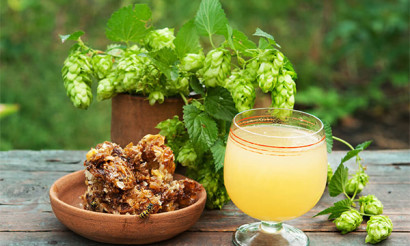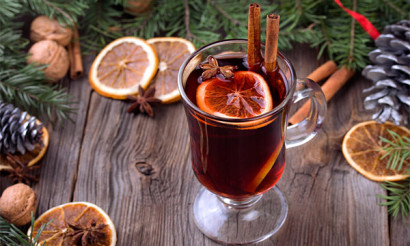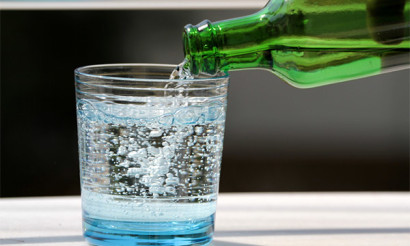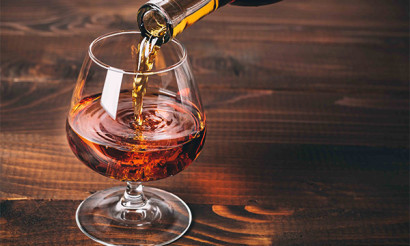White wine: useful properties and contraindications
For several decades, consumers and scientists do not stop discussing whether white wine has useful characteristics. And it is true that the useful and harmful features of such a product are ambiguous. On the one hand, alcohol, in principle, is not useful for human health, and on the other hand, science has proven that such a drink is characterized by a special composition. To understand this question, you should familiarize yourself with all the properties of white wine.
- Features of white wine production
- Types
- How white wine differs from red wine
- Which wine is healthier: white or red
- Composition and calories
- What is useful for white wine
- General Benefits
- For Women
- For Men
- While Pregnant
- For breastfeeding
- For children
- Slimming
- White Wine in Medicine
- Diabetes mellitus
- Pancreatitis
- Gastritis
- With gout
- At hemorrhoids
- Cholecystitis
- White Wine in Cosmetology
- Culinary Applications of White Wine
- Hazards and Contraindications
- How to Choose and Store White Wine
- How to test for naturalness
- How to Start Drinking White Wine
- How much you can drink per day
- Drinking it at bedtime and on an empty stomach
- What to drink with?
- Can we drink white wine after red?
- What Glasses to Drink from
- How to make a homemade white wine
- Rating of white dry wines
- Interesting facts about wine
Wine was very popular with our ancestors. It was respected and revered. It was an indispensable item on both rich and poor tables. In those days, white wine was used to quench thirst due to its loose structure. In Russia this product was used in especially large quantities. Wine was used instead of water, and then people did not even think about its useful and harmful properties.
As for the present time, today people can study various scientific studies that prove the harm of this alcoholic product. Therefore, it should be drunk in smaller amounts, or even excluded from the diet altogether.
Features of the production of white wine
People who are not particularly knowledgeable in the technology of obtaining a wine product, believe that for the production of red beverage dark grape varieties are used, while for white wine only light grape clusters are suitable. But this is not true. The white color results from the fact that the cooking process involves processing a special kind of grape without the skin. Therefore, even if the berry has a pronounced and rich color, the press from it will turn out almost colorless.
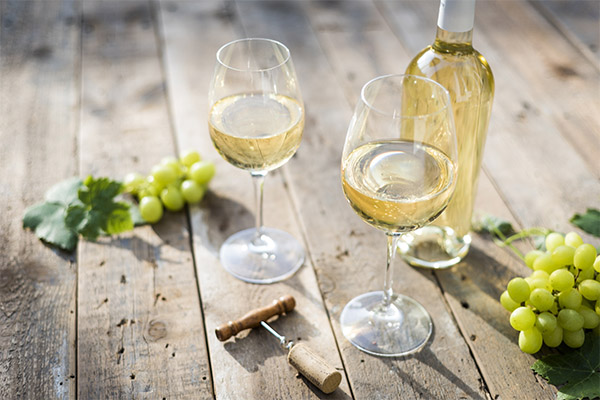
The color of the wine depends on the type of grapes used and certain technological nuances. High quality white wine is transparent, the hue of such a drink varies from pale yellow to amber.
Types of
There are several varieties of this alcoholic product. First, we should note the dry wine, its strength is 10-12 degrees, the sugar here contains no more than 0.3%. There is also a semi-sweet wine. The strength of such a drink is in the range of 12-15 degrees, the concentration of sugar is 5%. There is also a semi-sweet wine drink. It is characterized by a strength of 15%, the sugar content is about 7%. Another type is sweet or dessert drink. It is characterized by up to 17% strength and 10% sugar.
What is the difference between white wine and red wine
White wine is called white symbolically. As mentioned above, it may be almost transparent or have a hue reminiscent of brewed tea. Its whiter tones suggest that it is not aged in oak barrels, and it has a light and tangy flavor. Saturated colors indicate the wine was aged in oak barrels.
First of all, the two wines differ in terms of the raw material used. To make a white beverage, any color of grape fruit is used, but without the use of peel. To obtain red wine, only dark sorts of grapes are taken. Its peel contains a substance that gives the final product a special color. The fermentation of such a drink necessarily involves pips and peel of the fruit. It is these components that give the wine its tart flavor.
In the production of white wine you do not need aging, but to get a high-quality red, you need it.
Which wine is healthier: white or red?
Scientists have found out that of the two varieties, the red variety is more useful. The use of skins and seeds provides the drink with elements that prevent the development of anemia, reduce the likelihood of cardiovascular system diseases. There is also an astringent effect in the mouth after consuming the red beverage. This is a proof that it contains tannins. White wine does not contain such components.
It is proved that red wine has a positive effect on the body's protective shell, strengthening it. At the end of the 20th century, an American magazine published an article describing the results of an interesting experience. In this case, a team of volunteers consumed dry red wine daily for two weeks. At the same time, another group of participants drank white wine in the same volumes and for the same amount of time. As a result of this study, it became known that the level of antioxidants in the blood of people who drank a red drink reached its maximum concentration within 30 minutes and remained at this level for several more hours. And in the case of white wine, virtually no change could be found.
Composition and calories
In the composition of white wine some micro- and macroelements were found, including K, Ca, Mg, Na, P, Fe. However, the mass fraction of these compounds in the product of grape processing is very small, it is only about 3% of the daily rate.
Of vitamins in wine is found riboflavin, also known as B2. But its concentration is small.
In addition, white wine contains a number of acids, including lactic, tartaric and malic acids. The taste and flavor of the drink are achieved by amino acids and peptides. Also found in the product are components such as ammonia, aldehydes, esters and dietary fiber.
This alcoholic beverage has a sour taste, but this does not indicate that it contains ascorbic acid.
Speaking about the caloric value of dry white wine, it is worth noting that such a product can even be included in the list of diet drinks. It is often included in the diet when following a diet. The caloric value of this alcoholic product is about 70 kcal per 100 ml. This means that a bottle of wine, volume 700 ml, contains no more than 460 kcal.
What is useful for white wine
The general health benefits
The positive impact of this product on the body is due to the content of certain components in it. White wine is saturated with essential oils, various vitamins and mineral compounds. It contains antioxidants in small quantities, acids of organic origin. The drink is characterized by its bactericidal effect. It is even believed that adding a certain amount of wine to plain water after a while will kill all the microorganisms in it. When it enters the stomach, the resistance to viral bacteria increases, and various toxins are removed from the body.
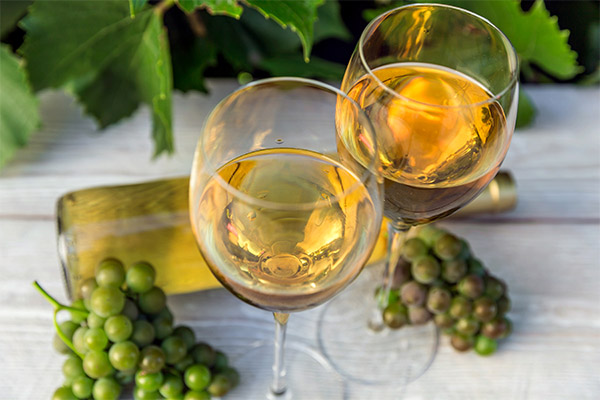
- White wine has benefits for the cardiovascular system. Regular consumption of this kind of drink in small doses contributes to the reduction of cholesterol, strengthens the vascular walls and the heart muscle.
- In addition, white wine helps in the treatment of diseases of the respiratory system. This product contains caffeic acid, which dilutes phlegm and facilitates its excretion. Thus, it is useful for pneumonia, bronchitis and even tuberculosis.
- Organic acids in wine improve substance metabolism, normalize the acidity of the stomach, restore digestion and ensure the absorption of amino acids from protein-rich foods.
- White wine's antioxidants fight radionuclides, resulting in a slower aging process.
- The product's nootropic properties are also known, meaning that drinking this type of wine improves memory and minimizes the risk of Alzheimer's disease.
Dry white wine has a low sugar content, so the product is suitable for quenching thirst. Continuous consumption of the drink ensures the removal of salts from the joints and kidney stones. If you dilute the wine with water, you can get rid of diarrhea. Consumption of chilled drink will eliminate nausea and vomiting. In addition, such a product is widely used in cosmetology. Its beneficial effects on the hair and skin have been found.
For women
Everyone knows that grape seeds are widely used in the production of cosmetics, which is designed to maintain youthfulness of the skin. Some part of these useful elements is also present in the drink made from grapes. White wine regulates the metabolism in the body, helps to reduce weight and maintain it at the right level. In addition, a glass of this drink helps to relieve nervous tension and prevent the development of stress. All this is characteristic only for dry wine. Sweet varieties can have a negative effect on the figure of girls.
For men
Male potency is in direct dependence on stressful situations, age and lifestyle. The benefit of such an alcoholic drink is to strengthen the nervous system. After a hard day, a glass of such a drink will help to tune in to rest. In addition, as mentioned, white wine restores the functions of the cardiovascular system. And, as we know, it is the male half of mankind who are more often exposed to the development of such diseases.
The danger of white drink lies in the excessive use of such a product. Most of all, as a result of this, the sexual system suffers, as well as the gastrointestinal tract - often there are ulcers of the mucous membranes.
In pregnancy
The use of white wine in large quantities will not do any good to a person. This is especially true for women who are expecting the birth of a baby. If it is normal for a normal person to consume not more than 100 ml of the product per day, but for pregnant women this figure is reduced to 25 ml, and you can drink it not every day.
The only indication for the consumption of such wine during pregnancy is anemia. Also sometimes the drink helps to normalize heart rhythms. If abused, alcohol syndrome can develop in the unborn child.
The use of such a product during the period of pregnancy is characterized by some restrictions. First of all, it is necessary to remember that in the first trimester the drink is consumed only in extreme cases. If the woman still decided to drink a small amount of wine, you should choose an expensive drink of high quality. It is not recommended to drink cocktails with such an alcoholic product.
When breastfeeding
White wine during lactation can do more harm than good. The negative effect extends not only to the woman, but also to the body of the small child. A woman before consuming such an alcoholic beverage should consider all the possible consequences of their use.
To reduce the likely risk, you should follow some rules during breastfeeding. To begin with, it is worth noting that it is not recommended to consume white wine on an empty stomach. You should also choose a quality drink with low concentrations of sugar and ethanol. It is better to drink in small sips, stretching a glass of drink for a couple of hours. Before drinking such alcohol, it is recommended to decant a certain amount of milk. After a glass of white wine, feeding is allowed only after five hours.
For children
Tasting wine for children is not allowed before the age of 16. Alcohol consumption at a child's age can destroy brain cells, inhibiting mental development. Alcoholic beverages lead to changes in the hormonal background, which causes aggression, reduced emotional stability, frequent changes of mood.
Wine is detrimental to the child's digestive system. The liver is the first to suffer, and there may even be a risk of developing cirrhosis. Alcohol provokes pancreatitis and stomach ulcers.
Wine negatively affects the heart and blood vessels. When a wine product is consumed, the alcohol immediately enters the heart. Such drinks lead to severe headaches, blood pressure spikes, and thinning of vascular walls, which can lead to hemorrhages.
When losing weight.
The question of whether it is possible to use white wine during weight loss has a rather ambiguous answer. Some experts prohibit the use of such a drink while maintaining a diet. Others believe that a small amount of wine will not harm the figure, and will help to get rid of unwanted pounds, as the product promotes metabolic processes and the breakdown of fats. In moderate volumes, the drink is able to saturate the body with useful elements, improve the work of the digestive organs, as a result of which the appetite decreases.
White wine in medicine
In white wine there are elements that are the prevention of cancer, as well as dementia, which manifests itself in old age. This product is characterized by its disinfectant and antiseptic properties. In addition, this grape drink can reduce cholesterol, restore normal metabolism, which makes it possible to apply it in the treatment of atherosclerosis, various stages of obesity and other pathologies that arise from disorders of substance metabolism.
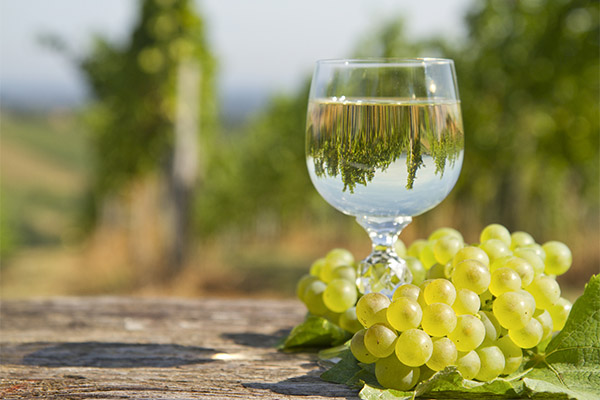
White wine is able to remove toxins and toxic substances from the body. Diluted drink can cure dysbacteriosis and diarrhea.
For Diabetes.
Patients with diabetes can use certified high quality wine, in the manufacture of which only natural raw materials were used. In this case, you need to adhere to the norm, which is 100-150 ml per day.
When drinking alcoholic product, it is important for diabetics to monitor the intake of drugs that normalize glucose and insulin levels. Alcoholic beverages can intensify the effect of the drug, which causes a sharp and severe decrease in blood glucose. Specialists advise to check the glycemic index before consuming a white drink and some time afterwards. If you adhere to the recommendations of doctors, no problems will arise.
Important: The glycemic index of white dry wine is 36 units, white semi-dry - 44.
Pancreatitis
In this disease, white wine is contraindicated. This is due to the fact that nowadays various aromatic and coloring substances are used to obtain such a drink, which have a negative effect on the pancreas. In addition, alcohol, in principle, ruins the tissue of the inflamed gland.
With gastritis
White wine is strictly forbidden to consume with inflammation of the mucous membrane of the stomach. Wine with high acidity can increase the synthesis of hydrochloric acid, which will lead to heartburn.
If you have gout
Numerous studies have proven that wine has the ability to cause gout attacks. After drinking wine, the risk of developing an exacerbation is much higher than after using another alcoholic product. During an exacerbation and for a month after a gout arthritis attack, it is not recommended to take alcoholic beverages. Alcohol can alter the effects of medications, increasing their effects and leading to their side effects.
In hemorrhoids.
People who drink large quantities of alcoholic beverages are twice as likely to suffer from hemorrhoids. This disease is characterized by pathology of the veins of the rectum. In this case, the vessels are deformed because of blood stasis. Wine, like other alcoholic products, leads to dilation of blood vessels. This increases blood flow to the inflamed hemorrhoid node, which leads to increased inflammation of the anal canal and the formation of new hemorrhoidal lumps.
Cholecystitis.
This disease is associated with disorders of the digestive system. Alcohol can only aggravate the situation. Wine can disrupt the synthesis and outflow of the enzyme. There may be disorders of substance metabolism, which will make it difficult to excrete cholesterol and cause the formation of gallstones in the gallbladder. In addition, alcoholic beverages contribute to changes in the bile microflora.
White wine in cosmetology
This drink has been widely used in cosmetology. Such a product is an ingredient of various masks for skin and hair.
For example, you can prepare ice and use it for cosmetic purposes for oily skin. For this you will need 10 grams of the herb St. John's wort and twice as much sage. These raw materials should be poured 60 ml of boiling water and insist for half an hour. After that, the mass should be strained and mixed with the same amount of white semi-dry wine. The resulting mixture should be poured into molds and placed in the freezer. Prepared pieces of ice is recommended to wipe the skin twice a day. Thirty minutes after application, you should rinse your face with cool water.
You can use wine to get a nourishing mask. It is required to grind the yolk of one egg with two spoons of sour cream, add 2 tablespoons of wine drink and a tablespoon of lemon juice. The ready mask should be applied for 20 minutes on the face, then rinse with warm water.
Wine can be used to prevent hair loss and get rid of dandruff. In this case, crush a few cloves of garlic and mix them with 50 ml of alcoholic product and a teaspoon of honey. The resulting mixture should be gently rubbed into the scalp, paying particular attention to the roots of the hair. Next, you should warm your head and keep the mask for 40 minutes. At the end of this time, you should wash your head with shampoo. Several such procedures will make the hair strong and strong, and dandruff will disappear.
Using white wine in cooking
For culinary purposes, it is recommended to use dry and semi-sweet varieties of white wine product. Its use is due to the presence of acids and alcohol, which makes the meat softer. Wine can be used in the manufacture of sauces and marinades. For meat with a delicate structure, a wine-based sauce can be used. For tougher types of meat, stewing in such a product is optimal. If the meat is very tough, it is recommended to marinate it in white wine beforehand.
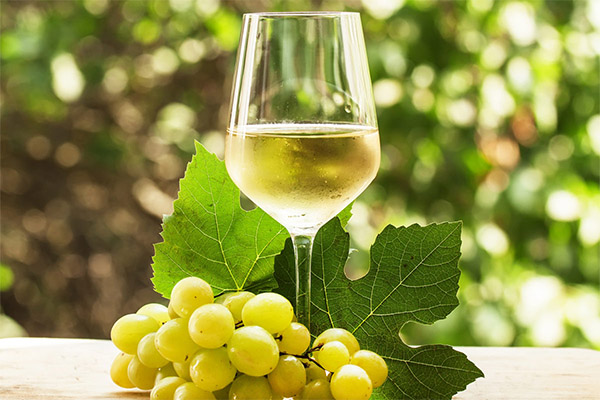
To prepare the sauce, you need to heat broth over low heat and add wine to it in a ratio of 2:1. The mass should be brought to a boil, then add the cream. Flour is needed to obtain the required consistency of the sauce. At the end you can add spices and spices to taste.
For the marinade, it is enough to take mineral water with wine in the same proportion as for the sauce. The meat should be completely immersed in the liquid. Keep it in this form is recommended for 6-8 hours, and better - the whole day.
Harm and contraindications
Despite the positive properties of this drink, white wine still refers to alcoholic products, the uncontrolled use of which negatively affects the cells of the brain, liver, digestive tract and mental health of a person. This wine is contraindicated for pregnant women, as well as during lactation. In addition, the drink should be excluded for those who have diseases of the digestive organs.
How to choose and store white wine
Only high-quality white wine, made of natural raw materials, may be endowed with useful properties. The label of a good wine should provide information about the winery and its representation in the region. The label glued around the neck of the container should indicate the date of harvest. No white sediment is allowed on the bottom of the bottle. This indicates that the product has not been stored properly. The cork should be flush with the neck of the container. If it has sagged, it means it has dried out, and air might have got into the wine, or if the cork protrudes, it is an indication of improper storage.
The optimal storage temperature for white wine is 10-12 degrees. Such a product does not tolerate heat or cold. Once the bottle is opened, oxygen enters the bottle, which oxidizes the drink and spoils it. An open bottle of wine can be kept for no more than 2-3 days.
How to test for naturalness
- To determine whether the wine is natural or not, you should pour a small amount of it into a glass and cover it tightly with your hand. Then you must pour the contents of the cup into a bowl of water. If as a result the water is colored, it means that the wine is not made with natural ingredients. Quality alcohol with water does not mix because these liquids have a different density.
- You can pour a little wine into a shot glass and add to it baking soda. One teaspoon will be enough. The natural product will turn brown or gray during the chemical reaction, while the powder mixture will remain the same.
How to drink white wine correctly
It is recommended to serve the wine at a temperature no higher than 14 degrees. The glass should be filled approximately one-third full, and the wine should be drunk in small, slow sips.
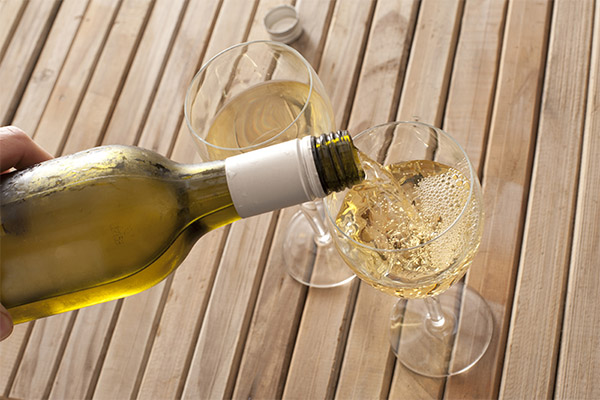
The glass with the drink should first be held up and away from the nose a few times, then shaken slightly to get the oxygen into the wine. To determine the taste, you should first sip a little, but not swallow it, but hold it in your mouth for a few seconds. For the taste of the drink to be fully revealed, you should slightly open your mouth and suck in some air.
How much you can drink per day
WHO has established the following norms of wine consumption: for men - up to three glasses of dry drink, for women - no more than two glasses of such wine. One glass implies no more than 150 ml. However, it should not be done every day. After a single intake, you can drink white wine again in a few days.
Can you drink it at night and on an empty stomach
Various experiments have proven that if you drink wine before going to bed, you can fall asleep much faster. This is explained by the fact that the product has a sedative effect. But at the same time, it is proven that it is enough to drink such a product at night for three days in a row to develop an addiction. That is, each time you will need to drink a larger amount for the sedative effect.
It is not recommended to consume white wine on an empty stomach, because after half an hour its concentration in the blood will be maximum, which will lead to a rapid intoxication. In addition, this alcoholic drink, if used on an empty stomach, will have a negative impact on the state of internal organs, especially if any of them is inflamed.
What to drink with
White wine can be combined with fish and vegetable dishes, flour products, cheeses. Fruits and various desserts are also suitable. When choosing appetizers, remember that they should be light, without a lot of spices and seasonings.
With semi-dry wine you can serve sushi and various meat-based dishes, for example, chicken pâté.
Can I drink white wine after red wine?
You should not mix different drinks. No matter which one is consumed first or they are served mixed, the next day there will be a severe hangover with headaches and nausea. To protect your body from such experiments, you need to stock up on special remedies.
What glasses to drink from
Fougères should be made of thin and transparent glass. The glass should have a high stem, which should be held while drinking. Otherwise the contents will heat up by hand. For white wine it is recommended to use glasses of no more than 350 ml with the bowl gradually widening towards the neck. A quarter of the container should remain empty.
How to make homemade white wine
To make white wine at home it is recommended to use such varieties as Aligote and Riesling.
First, you should prepare the grapes by removing all twigs and debris. It is not necessary to wash the raw material. Next, the berries should be crushed in a non-metallic bowl so that you get as much squeeze as possible. The resulting liquid should be strained. To make a sweet wine, you should add a glass of sugar for every liter of juice. After that, pour the liquid into a container, filling it only 2/3 full. Close the bottle with a lid, on which you make a hole and insert a tube. It should be blown out and dropped into the dish with water. The cap should be tightly sealed, you can even wax its edges.
In this form, the bottle should be stored in a cool and dark place for 2-3 months. The water in the bucket should be changed regularly. After the specified time, the wine must be filtered again, and then pour into clean bottles, which should be closed tightly with lids.
Rating of white dry wines

- Pino Grigio Torresella is an Italian drink with a pale straw color. It has a refreshing taste with a slight bitterness. It is served with fish and cheese soups.
- Bosio Gavi is also an Italian product, a slightly yellowish hue. It has the aroma of fruit and spring flowers. It is characterized by a long aftertaste, it has a sourness. Goes well with fish products, as well as vegetables.
- Pratello Lugana also represents Italy, characterized by its golden color. The aroma combines notes of peach and banana. It is served with roasted poultry and oven-baked fish.
- Pavillon Blanc Du Chateau Margaux Bordeaux AOC is a French drink with a slightly golden color. The aroma recalls spring flowers and musk. It tastes of pineapple and gooseberry, in the aftertaste there is oak and green apple. The drink is in harmony with French cuisine.
- Javier Sanz Collecion V Malcorta is a Spanish production wine with an almost white color. It has a high degree of acidity and tart flavor.
- Arabarte Blanco is also a Spanish product. The drink has a yellowish color. There are elements of rare tropical and citrus fruits in its aroma. The wine is very light and refreshing in summer. It can be served with some kinds of cheese, as well as with seafood.
- Casillero del Diablo Sauvignon Blanc Reserva is made in Chile. It has a yellowish color, with an aroma of tropical fruits, lime and pear. Pour the drink with seafood.
- Koonunga Hill Chardonnay is a representative of Australia. It is characterized by a pale straw color. Its aroma is reminiscent of white flowers, oak wood, grapefruit. The drink itself is a little sour. Excellent with white meat, as well as Asian dishes.
- Loureiro is a drink that comes from Portugal. It is easily identified by its fresh and rich aroma, which combines aromas of spring flowers and citrus fruits. It has a sour taste. Suitable for fish dishes as well as poultry.
- Tsinandali Iberiuli Shumi is a Georgian wine with a specific aroma that combines flavors of citrus, fresh tobacco, flowers and oak. The alcoholic beverage is served with cold snacks, meat dishes.
Interesting facts about wine
- During the ancient Greek feast, the host always tasted the alcoholic beverage first, so that those present could be sure that the product was not poisoned. This is where the expression "drink to health" came from.
- Wine tasting is based on an appreciation of taste, which is why women are the best tasters.
«Important: All information on this site is provided for informational purposes only purposes. Consult with your health care professional before applying any recommendations. specialist before using the recommendations. Neither the editors nor the authors shall be liable for any possible harm caused by materials."

